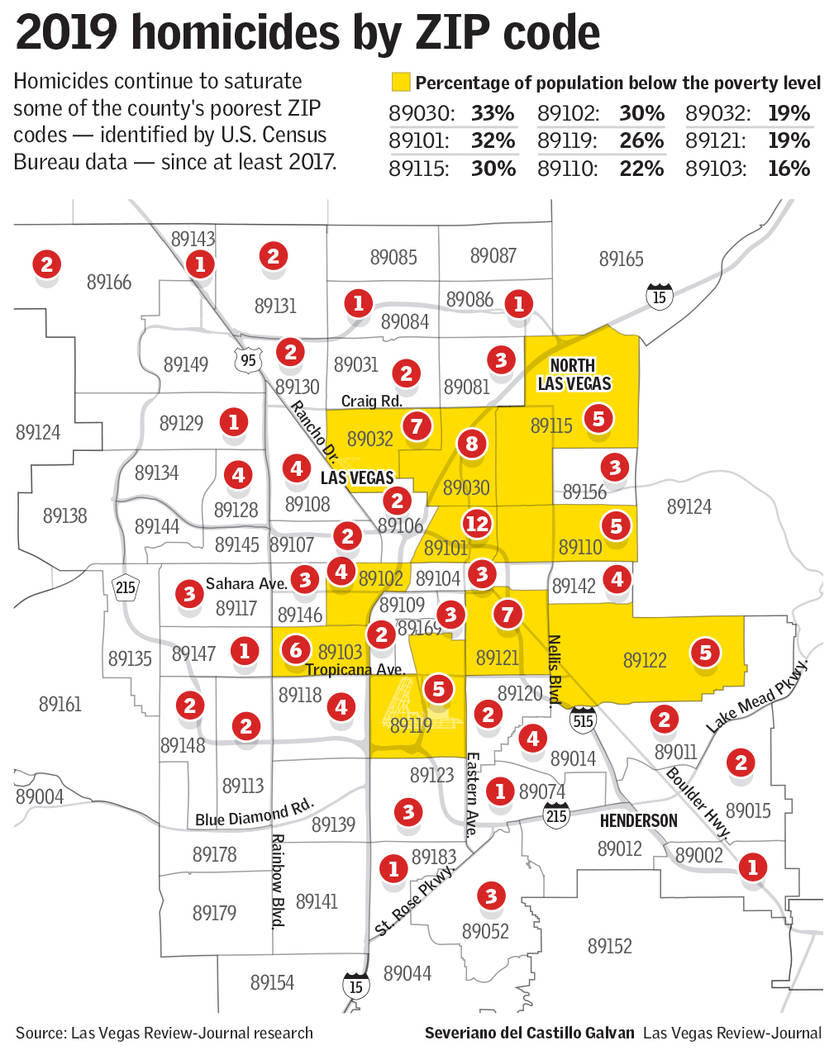Clark County saw its most drastic drop in homicide investigations in at least a decade last year, down 33 percent from the previous year.
As of New Year’s Day, 144 homicides had been investigated in 2019 by Las Vegas, North Las Vegas, Henderson and Boulder City police compared with the 216 investigated in 2018, according to records maintained by the Review-Journal, which tracks all homicides in the county — including those involving police shootings, accidental shootings and cases of self-defense.
Metropolitan Police Department statistics largely drove the plunge in last year’s numbers. The department investigated 109 homicides, down from 161 in 2018, according to Review-Journal records.
“Since I’ve been elected sheriff, since day one, my priority has been violent crime,” Clark County Sheriff Joe Lombardo told the Review-Journal on Friday. “So all of our resources, all of our direction, has been focused towards that, and it’s bearing fruit.”
The homicide total could later increase as a cause and manner of death is determined for pending cases, including the six victims killed last month in a fire at the Alpine Motel Apartments, the deadliest residential fire in the city’s history. Metro’s homicide section has opened a criminal investigation into the fire.
In the Las Vegas Valley, only the North Las Vegas Police Department includes fatal police shootings in its official homicide count. Metro follows uniform crime reporting guidelines, established by the FBI, when tallying its official homicide count.
As the largest police department in Southern Nevada, overseeing the city of Las Vegas and unincorporated Clark County, Metro’s annual homicide count often sways the trend in killings for the entire county. Yet North Las Vegas and Henderson police also responded to fewer killings following a particularly bloody 2018, the deadliest year on record for both cities.
The solvability rate for each jurisdiction is higher than 80 percent, surpassing the national average of 62 percent. A case is considered solved when an arrest has been made or a suspect has been identified.
‘Fresh eyes’
Despite a growing population in the valley, Review-Journal records show, Metro’s homicide investigations have been on a downward trend since 2018, after a record number of killings the previous year. It marked the first decrease in homicides for the department since at least 2012.
“You would think, if you just took it at face value, we would increase in homicides, not decrease,” said Lombardo, who largely credits the downward trend to the additional officers he has hired in recent years. “I think that has probably had the most significant cause and effect on our crime numbers, to include homicides.”
In June, the department achieved a ratio of two officers for every 1,000 valley residents, he said. And more officers on the streets means Lombardo can integrate members from all reaches of the department to assist in investigations.
“Traditionally in the homicide world and in all of police work, not just in Las Vegas Metro, your intelligence and your police work was siloed,” he said Friday. “In other words, homicide stood alone on their own, and we relied solely on homicide to solve that particular crime. In today’s age and design and direction, we include all aspects of the department to help.”
Other changes came to Metro’s homicide division in March 2018, when Lt. Ray Spencer took over the section.
“We put an extraordinary amount of resources into every case, no matter what the case involves,” Spencer said in December. “Where other agencies are limited by manpower and other issues, we will put as much personnel and as much money needed to get the case solved.”
Spencer brought different investigative techniques to the section, including what he calls a “90-day fresh eyes” peer review: If after 90 days a homicide remains unsolved, Spencer will give the case to a different set of investigators.
“We put a fresh set of eyes on it,” he said. “What used to just remain with one detective is now passed on and peer-reviewed.”
And from his vantage point, Spencer attributes the department’s high solvability rate to the peer review, along with a county-wide expansion of gunfire detection technology, Metro’s growing digital forensic team and an increase in the capacity of the department’s DNA laboratory.
ShotSpotter, a network of audio sensors designed to detect and report gunfire, was first piloted by Metro and Clark County officials in 2017.
“Now two years later we’re really seeing the effect,” Spencer said.
After success during the pilot program, officials in October began expanding coverage areas across more than 23 square miles of the valley in roughly eight persistent “hot spots” for violent crime.
Metro previously has said ShotSpotter can report 86 percent of shootings faster than the average 911 caller, meaning paramedics can get to victims more quickly while officers can lock down a crime scene and detain witnesses or suspects. During the pilot phase, according to Metro, more than 485 shootings that would have otherwise gone unreported were detected by the technology.
ShotSpotter in action
Such was the case on the night of Dec. 18, when Terry Louie was shot inside his car during an attempted robbery on the 2000 block of Wengert Avenue, by a man he apparently owed money to, police have said.
No one called 911. But ShotSpotter alerted police.
After he was shot in his right thigh, Louie drove off but crashed into a parked vehicle about 200 yards north, on Crestwood Avenue, where officers would eventually find him dead in the driver’s seat. He was 61.
Thanks to the ShotSpotter notification, homicide investigators had a timeframe for the shooting and were able to track down surveillance footage in the area that helped identify and arrest a suspect just four days later.

Estranged from his family, the Glendora, California, native had been trying to reconnect with his relatives for years, according to his longtime friend, Deanna Bingerman.
Louie was a private but kind-hearted man who battled demons most of his life. He was a drug addict, Bingerman said.
But he had been sober for 12 years — until recently.
“He took very good care of his friends, but I think being alone in sobriety was too much for him,” she said. “I just want his family to know he was doing fantastic for those 12 years. He was mentoring people in sobriety. He took people in. We were all his extended family. Terry had a lot of good qualities, and for him to relapse was hard for all of us.”
But perhaps the most heartbreaking aspect of Louie’s death, Bingerman said, is that after spending most of his life looking for his family, he died alone.
“Terry was, and still is to me, a very good person,” she said. “He was just very lonely.”
But she has found some comfort in knowing he wasn’t alone for too long that night.
“They apparently found him right away because of the gunshot notification,” she said. “So there’s that, at least.”
Homicides by ZIP code
Still, gun violence continues to be the leading cause of death in Clark County with gunshot wounds killing 68 percent of homicide victims last year, though down from 73 percent in 2018, according to Review-Journal records.
And despite the significant slash in Clark County’s homicides last year, killings have continued to saturate some of the county’s poorest zip codes — identified by U.S. Census Bureau data — since at least 2017.

The majority of homicides are clustered in east Las Vegas, the southern portion of North Las Vegas and in and around the Historic Westside, a roughly 3.5-square-mile neighborhood just northwest of downtown Las Vegas known for its storied African-American culture.
“If you look at some of the experiments done in police work across the nation in years past, a predominant amount of your violent crime comes from your poorest neighborhoods, and I think that’s an educational piece for officers,” Lombardo said. “So officers need to be aware of that, and how they police in those neighborhoods compared to other neighborhoods needs to be evaluated.”
In 2017 and 2018, ZIP code 89030 in North Las Vegas led the county in homicides. It came in second to ZIP code 89101 in 2019.
Situated in 89030 is a deadly zone identified by the Review-Journal after a spate of gun violence targeting school-aged children and teens in late 2018, which drove homicide numbers to a record high of 36 that year in North Las Vegas, spilled into 2019.
In response, North Las Vegas police Chief Pamela Ojeda added a new patrol squad into the area, and has done so since for other “hot beds” of crime in the city.
“Last year we had very high homicide numbers, and it was tragic,” she said in late December. “We did a whole bunch of reorganization, putting the right people in the right positions, where they have better access to the community.”
The team she embedded in the deadly zone last year was part of the department’s problem-solving unit. As of late December, the team consisted of seven members, including a sergeant. But Ojeda plans to add officers to the team this summer, “because it’s very successful.”
“Their hours are constantly changing, because they saturate the entire city,” Ojeda explained. “So wherever we see a rise in crimes, they make a special plan and then go into that area until they bring that crime rate down.”
Across town in Henderson, city police investigated 12 homicides last year, down from 17 in 2018. The Henderson Police Department’s record number of killings in 2018 was driven by domestic murder-suicides.
Henderson’s police chief was not available for an interview regarding this story, but in June, homicide Detective Wayne Nichols told the Review-Journal he hadn’t noticed any trends that stood out to him during the first half of the year. He suggested that the uptick in homicides in 2018 was due in part to a rise in population over the past few years.
But while homicides decreased in 2019, the number of Henderson police shootings more than doubled. In 2018, city police investigated three police shootings, two of which were fatal, compared with eight — two also fatal — in 2019.
Contact Rio Lacanlale at rlacanlale@reviewjournal.com or 702-383-0381. Follow @riolacanlale on Twitter.


